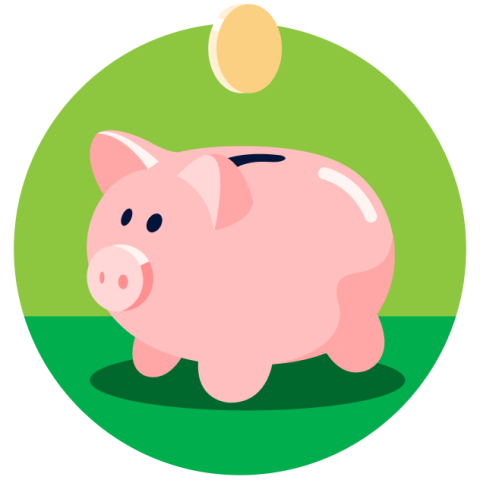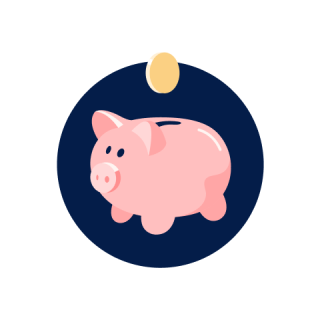What Is a High-Yield Savings Account?

Many or all of the products featured here are from our partners who compensate us. This influences which products we write about and where and how the product appears on a page. However, this does not influence our evaluations. Our opinions are our own. Here is a list of our partners and here's how we make money.
High-yield savings accounts defined
A high-yield savings account is a savings account that earns an above-average interest rate on deposits, allowing your bank balance to grow faster than with traditional options. The average national rate for savings accounts is 0.46%, but a high-yield savings account earns up to 10 times that rate or more.

High-yield savings accounts, also called high-interest savings accounts, are typically federally insured, just as traditional savings accounts are. Accounts are covered up to $250,000 per depositor, per insured bank and per account ownership category. “Ownership category” refers to different types of legal ownership. Examples include “single” (owned by one person) and “joint” (owned by two or more people). See the section below on keeping your money safe for more details about federal insurance. If you want to earn more interest on your money, compare today’s best high-yield savings accounts. They can boost your savings balance without much effort on your part.
Which banks have the best savings interest rates?
High-interest savings accounts are typically offered by online-focused banks and credit unions. These institutions don’t have the expense of maintaining branches like brick-and-mortar banks and credit unions do, and they can pass the savings on to customers by offering higher yields.
Many online savings accounts also have no monthly maintenance fees. That can go a long way toward boosting your bank balance.
» Understand: Learn the difference between APY and interest rate

Member FDIC
Barclays Online Savings Account

4.35%
$0

Member FDIC
EverBank Performance℠ Savings

5.15%
$0
Examples of three high-interest online savings accounts
Discover Bank, 4.25% APY, no minimum opening deposit
Discover Bank's online savings account offers a 4.25% annual percentage yield, or APY, with no minimum balance. There are also no monthly fees.
Varo, 3.00% APY, no minimum opening deposit
Varo offers a savings account in which you can earn a rate of 3.00% APY with just the first penny deposited. And there is no monthly fee. Varo also gives you the opportunity to earn 5.00% APY on balances up to $5,000 if you meet other account requirements.
Bask Bank, 5.10% APY, no minimum opening deposit
The Bask Interest Savings Account earns a strong rate of 5.10% APY. There is no minimum deposit required, and there are no monthly fees.
How to choose the best high-yield savings accounts
Start by looking for banks with the highest rates; these days, anything above 4% APY is a solid return. Then take a look at the requirements to open the account. With some banks, you must have a certain minimum deposit — such as $1,000. Others offer a competitive rate without minimums or restrictions. Consider whether you'll have ATM access, good customer service, and quality mobile apps and remote deposit features. NerdWallet’s bank and credit union reviews take all these factors into account when researching banks. It’s also a good idea to confirm that the funds will be federally insured.
Is my money safe in a high-yield savings account?
Putting your money in a federally insured high-interest savings account is safe. Funds at covered banks are insured up to $250,000 per depositor, per ownership category by the Federal Deposit Insurance Corp., or FDIC. At credit unions, the National Credit Union Administration, or NCUA, has a fund that also federally insures up to $250,000 per depositor. This means that you won’t lose your money, up to this amount, if the bank or credit union goes under. Apart from checking your institution's website, you can make sure it's covered by searching for it using the FDIC’s BankFind search page (for banks) or the NCUA’s research page (for credit unions). To learn more, read NerdWallet’s primers on FDIC and NCUA insurance.
Do the math on high-yield savings
When you put money in an account that earns a high interest rate, your balance grows faster than with a low-yield option. Want to see how fast your savings can grow? Use NerdWallet’s savings calculator to estimate your balance over time.
With a 4% APY, a savings balance of $1,000 would earn about $41 after a year. It may not make you rich, but the earnings are much better than in an account with an APY of, say, 0.50%, which would earn about $5 during the same time period.
And interest in a savings account compounds — which means the interest you earn on your money also earns interest. Take that same $1,000. If you leave it in your 4% APY account for three years and it "compounds" interest each month, you’ll earn about $127. (Without compounding, you’d earn interest only on the original $1,000 each year. So you’d earn $41 a year for three years, for a $123 total.)
» Did you get a raise? Here's what to do with the money When you have money in savings, compounding time frames make a difference. For example, instead of having an account that compounds monthly, some savings accounts compound daily, and that gives your money more opportunities to grow. You can add up how much you could save with daily, monthly or annual compounding interest using NerdWallet’s compound interest calculator.

Best uses for a high-yield savings account
High-yield savings accounts are a great place for your emergency fund. Your money is parked in a safe place, and the APY boosts your savings balance. You can also use high-yield savings accounts to put money away for short-term goals, such as the down payment on a house, a big vacation or a rainy day fund to cover repair or maintenance expenses. You’ll know you’re earning interest, and there’s not the risk of losing your principal as there is with investment accounts. However, an investment account may be a better way to go for longer-term savings goals, such as saving for retirement, as the returns may be higher over time.
» Looking for more? Read our picks for the best high-interest accounts
How often do savings rates change?
Savings rates are variable and technically can change at any time. In practice, it’s common to see a bank’s rate remain the same for several weeks in a row. But if the Federal Reserve recently cut rates or increased them, you will often see several banks change their savings rates around the same time.
How to open a high-yield savings account
Depending on the type of bank or credit union, you can open a high-rate account either online or in person:
1. Provide contact information. Be prepared to share your Social Security number and at least one form of identification, such as a driver’s license or a passport. (For a joint account, everyone wanting access to the account must provide this information and ID.)
2. Sign up for online access, if you'll be managing your account with your desktop or mobile device. You’ll typically need to create a username and password to log in to the account online. For security, choose a strong password that’s hard to guess and is different from passwords you have for other accounts.
3. Make a deposit. A bank will generally let you set up a transfer from an existing bank account, set up a wire transfer, or provide a check or cash.
What happens if I can’t open a savings account?
Not everyone who applies to open a new bank account gets approved on their first try. If you apply online, for example, the financial institution may not be able to confirm your identity. Or you may have a negative banking history — such as a past unpaid bank fee — that another institution reported to a consumer reporting agency, such as ChexSystems. If you’re unable to open a savings account, you can take steps to get your consumer file on track. For example, you may be able to open a second chance bank account. That way, you’d have an opportunity to establish a solid banking history for a few months or a year. Then, you’d be in a much better position to shop around for a higher-yield option and successfully open a new account.
The bottom line
The best high-yield savings accounts can help you grow your money faster than basic options. They pay many times more than the national average of 0.46%.
On a similar note...
Find a better savings account
See NerdWallet's picks for the best high-yield online savings accounts.
⏰ Limited-time offer
4.60%
With $0 min. balance for APY
$300
Limited-time offer
Earn up to $300 with direct deposit. Terms apply.








